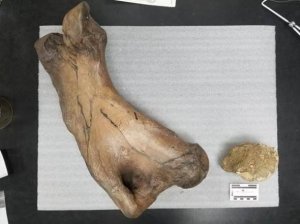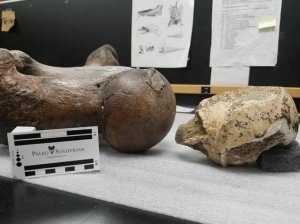Two partial bones belonging to large, ancient mammals were recently discovered some 16 feet under Crenshaw Boulevard, the Los Angeles County Metropolitan Transportation Authority announced Thursday.

The “amazing” discovery was made on May 16, on Crenshaw between 63rd Street and Hyde Park Boulevard, in the Hyde Park area of South Los Angeles, according to a Metro news release.
It took roughly eight days to identity both fossils, which was done with the assistance of Gary Takeuchi at the La Brea Tar Pits and Museum.
The first fossil was identified as the right proximal radius of an ancient bison; the second was determined to be proximal femur head fragment of a sloth.
“This is an amazing discovery. If this is a Harlan’s Ground Sloth (the largest and most common of three species of ground sloth found at the Tar Pits) then the animal could have easily weighed up to 1,500 pounds and measured up to 10 feet in length,” the Metro news release stated.

Based on the assumption that the bones fragments are the same age as the La Brea Tar Pits, the Harlan’s Ground Sloth likely lived in the L.A. area about 11,000 to 40,000 years ago, in the late Pleistocene area, according to the release.
Many large mammals in the region went extinct at least 10,000 years ago, following the last Ice Age. Among them were sloths, bison, ancient camels, mastodons and mammoths.
Bones belonging to an ancient camel and a mastodon or mammoth were uncovered earlier this year while crews excavated an area beneath Wilshire Boulevard as part of the Metro’s Purple Line extension project.
The latest two fossils discovered are currently being held at the Paleo Solutions laboratory. They will eventually be transferred elsewhere, possibly to the Natural History Museum of Los Angeles County.















